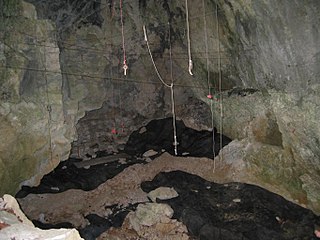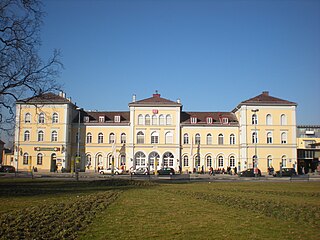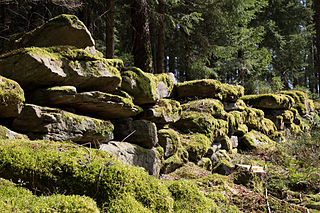Related Research Articles

Baden-Württemberg is a state in southwest Germany, east of the Rhine, which forms the border with France. It is Germany’s third-largest state, with an area of 35,751 km2 (13,804 sq mi) and 11 million inhabitants. Baden-Württemberg is a parliamentary republic and partly sovereign, federated state which was formed in 1952 by a merger of the states of Württemberg-Baden, Baden and Württemberg-Hohenzollern. The largest city in Baden-Württemberg is the state capital of Stuttgart, followed by Karlsruhe and Mannheim. Other cities are Freiburg im Breisgau, Heidelberg, Heilbronn, Pforzheim, Reutlingen and Ulm.

The Upper Rhine is the section of the Rhine in the Upper Rhine Plain between Basel in Switzerland and Bingen in Germany. The river is marked by Rhine-kilometres 170 to 529.

Further Austria, Outer Austria or Anterior Austria was the collective name for the early possessions of the House of Habsburg in the former Swabian stem duchy of south-western Germany, including territories in the Alsace region west of the Rhine and in Vorarlberg.

Upper Swabia is a region in Germany in the federal states of Baden-Württemberg and Bavaria. The name refers to the area between the Swabian Jura, Lake Constance and the Lech. Its counterpart is Lower Swabia (Niederschwaben), the region around Heilbronn.

The Upper Swabian Baroque Route is a tourist theme route through Upper Swabia, following the themes of "nature, culture, baroque". The route has a length of about 500 km. It was established in 1966, being one of the first theme routes in Germany. There is an extension to the route into Switzerland and Austria around Lake Constance.

Schöntal Abbey is a former Cistercian abbey in Schöntal in the district of Hohenlohe, Baden-Württemberg, Germany. It is famous as one of the most impressive pieces of Baroque architecture in northern Württemberg and is now used by the Diocese of Rottenburg-Stuttgart as a retreat and training centre.

The Ulm–Friedrichshafen railway, also known as the Württembergische Südbahn, is a non-electrified main line in the state of Baden-Württemberg, southern Germany. It was built from 1846 to 1850 and doubled from 1905 to 1913. During that time many of the station buildings were rebuilt. Its kilometre numbering begins as the Fils Valley Railway in Stuttgart Hbf.

Geissenklösterle is an archaeological site of significance for the central European Upper Paleolithic, located near the town of Blaubeuren in the Swabian Jura in Baden-Württemberg, southern Germany. First explored in 1963, the cave contains traces of early prehistoric art from between 43,000 and 30,000 years ago. In 2017 the site became part of the UNESCO World Heritage Site Caves and Ice Age Art in the Swabian Jura.

Werd Island is the main island of the small island group Werd Islands in the westernmost part of the Lower Lake of Lake Constance just before the High Rhine leaves the part of the lake known as Rheinsee. It is located on Swiss territory between Stein am Rhein and Eschenz.

Friedrichshafen Stadt (city) station is the largest railway station of the city of Friedrichshafen on Lake Constance (Bodensee) and a railway junction in the German state of Baden-Württemberg. It has five tracks and is classified by Deutsche Bahn as a category 3 station. Each day it is used by about 160 trains operated by Deutsche Bahn and the Bodensee-Oberschwaben-Bahn (BOB). Ulm–Friedrichshafen railway from Ulm ends at the station, where it meets the Lake Constance Belt Railway. Another major railway station in the city, Friedrichshafen Hafen station, which is operated as part of Friedrichshafen Stadt station, was used until 1976 for loading and unloading carriages on the Lake Constance train ferry to Romanshorn in Switzerland.

The Upper Germanic-Rhaetian Limes, or ORL, is a 550-kilometre-long section of the former external frontier of the Roman Empire between the rivers Rhine and Danube. It runs from Rheinbrohl to Eining on the Danube. The Upper Germanic-Rhaetian Limes is an archaeological site and, since 2005, a UNESCO World Heritage Site. Together with the Lower Germanic Limes it forms part of the Limes Germanicus.
Angelos Chaniotis is a Greek historian and Classics scholar, known for original and wide-ranging research in the cultural, religious, legal and economic history of the Hellenistic period and the Roman East. His research interests also include the history of Crete and Greek epigraphy. Chaniotis is a Professor in the School of Historical Studies at the Institute for Advanced Study in Princeton.

The Neckar-Odenwald Limes is a collective term for two, very different early sections of the Upper Germanic-Rhaetian Limes, a Roman defensive frontier line that may have been utilised during slightly different periods in history. The Neckar-Odenwald Limes consists of the northern Odenwald Limes (Odenwaldlimes), a cross-country limes with camps, watchtowers and palisades, which linked the River Main with the Neckar, and the adjoining southern Neckar Limes (Neckarlimes), which in earlier research was seen as a typical 'riverine limes', whereby the river replaced the function of the palisade as an approach obstacle. More recent research has thrown a different light on this way of viewing things that means may have to be relativized in future. The resulting research is ongoing.
The Alb Limes is a Roman frontier fortification or limes of the late 1st century AD in the Swabian Jura, also known as the Swabian Alb. The Alb Limes runs for just under 135 kilometres from Rottweil in the southwest to Heidenheim an der Brenz in the northeast.

The Rinkenwall or Rinkenmauer is a circular rampart fortification at the southeastern tip of the Rinkenkopf mountain above the Murg valley near the village of Baiersbronn in the county of Freudenstadt in the south German state of Baden-Württemberg.
The Lautertal Limes is a Roman limes section of the early 2nd century which is located between the River Neckar and the Swabian Jura. It extends for a distance of 23 kilometres (14 mi), running, straight as a die, from the present-day municipality of Köngen on the Neckar in the northwest to Donnstetten in the Swabian Jura to the southeast.

The Danube–Iller–Rhine Limes or DIRL was a large-scale defensive system of the Roman Empire that was built after the project for the Upper Germanic-Rhaetian Limes in the late 3rd century AD. In a narrower sense the term refers only to the fortifications between Lake Constance and the River Danube (Danubius); in a broader sense it also includes the other Late Roman fortifications on the Upper Rhine (Rhenus) and Upper Danube.

The Limesfall is the name given to the abandonment of the Upper Germanic-Rhaetian Limes in the mid-3rd century AD by the Romans and the withdrawal of imperial troops from the provinces on the far side of the rivers Rhine and Danube to the line of those rivers. It is sometimes called the fall of the limes.
Udelgard Körber-Grohne was a German archaeobotanist.
References
- ↑ Breuer, E. Byzanz an der Donau, 2005, page 5.
- ↑ Meyer, M. Ein römerzeitliches Gräberfeld bei Mochenwangen. Fundberichte aus Baden-Württemberg 27, 2003, Reference 11.
- ↑ Meyer, M.G.M. Die laendliche Besiedlung von Oberschwaben zur Roemerzeit. Materialhefte zur Archaeologie in Baden-Württemberg 85. (Stuttgart 2010) page 299-300.
- ↑ Breuer, E., Roemer am noerdlichen bodensee (Tettnang 2001), page 5.
- ↑ Breuer, E., Römer am nördlichen Bodensee (Tettnang 2001), page 16-17
- ↑ Meyer, M.G.M. Die laendliche Besiedlung von Oberschwaben zur Roemerzeit. Materialhefte zur Archaeologie in Baden-Württemberg 85. (Stuttgart 2010) page 160-172, 281.
- ↑ Planck, D. (2005). Die Römer in Baden-Württemberg. Stuttgart. ISBN 3-8062-1555-3. page 80.
- ↑ Bilamboz, A. Der Stand der Dendrochronologie für die Römerzeit in Baden-Württemberg. Festschr. Planck. Stuttgart 2009 page 669, 675.
- ↑ 750 Jahre Eriskirch (Tettnang 2007), page 23. ISBN 3-88812-208-2.
- ↑ Klaudios Ptolemaios, Handbuch der Geographie (Basel 2006), ISBN 3-7965-2148-7
- ↑ Klaudios Ptolemaios, Handbuch der Geographie (Basel 2006),2,12,5, Europa, 5. Karte ISBN 3-7965-2148-7
- ↑ Bürgi, J. and Hoppe R., Schleitheim-Iuliomagus. Die römischen Thermen. Antiqua 13. (Basel 1985)
- ↑ Meyer, M.G.M. Die laendliche Besiedlung von Oberschwaben zur Roemerzeit. Materialhefte zur Archaeologie in Baden-Württemberg 85. (Stuttgart 2010) page 160-172, 281-282, 299-300.
- ↑ Ungerman, Šimon., Breuer, E: Byzanz an der Donau. Archeologické rozhledy, 2006, 58, 368-374.
- ↑ Cum grano salis. Beiträge zur europäischen Vor- und Frühgeschichte Festschrift für Volker Bierbrauer zum 65. Geburtstag. Hrsg. von Bernd Päffgen, Ernst Pohl, Michael Schmauder. Likias, Friedberg 2005, (see Verzeichnis der von Volker Bierbrauer betreuten Magisterarbeiten und Dissertationen ) ISBN 978-3980762854
- ↑ Eric Breuer, Byzanz an der Donau, 2005, page 30, 118-121.
- ↑ Eric Breuer, Byzanz an der Donau, 2005, page 6-9.